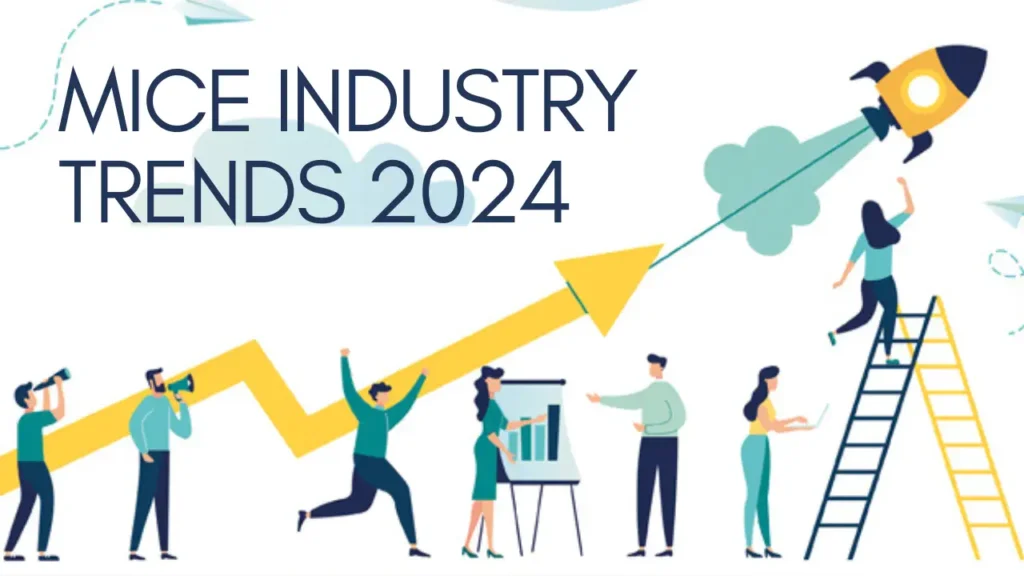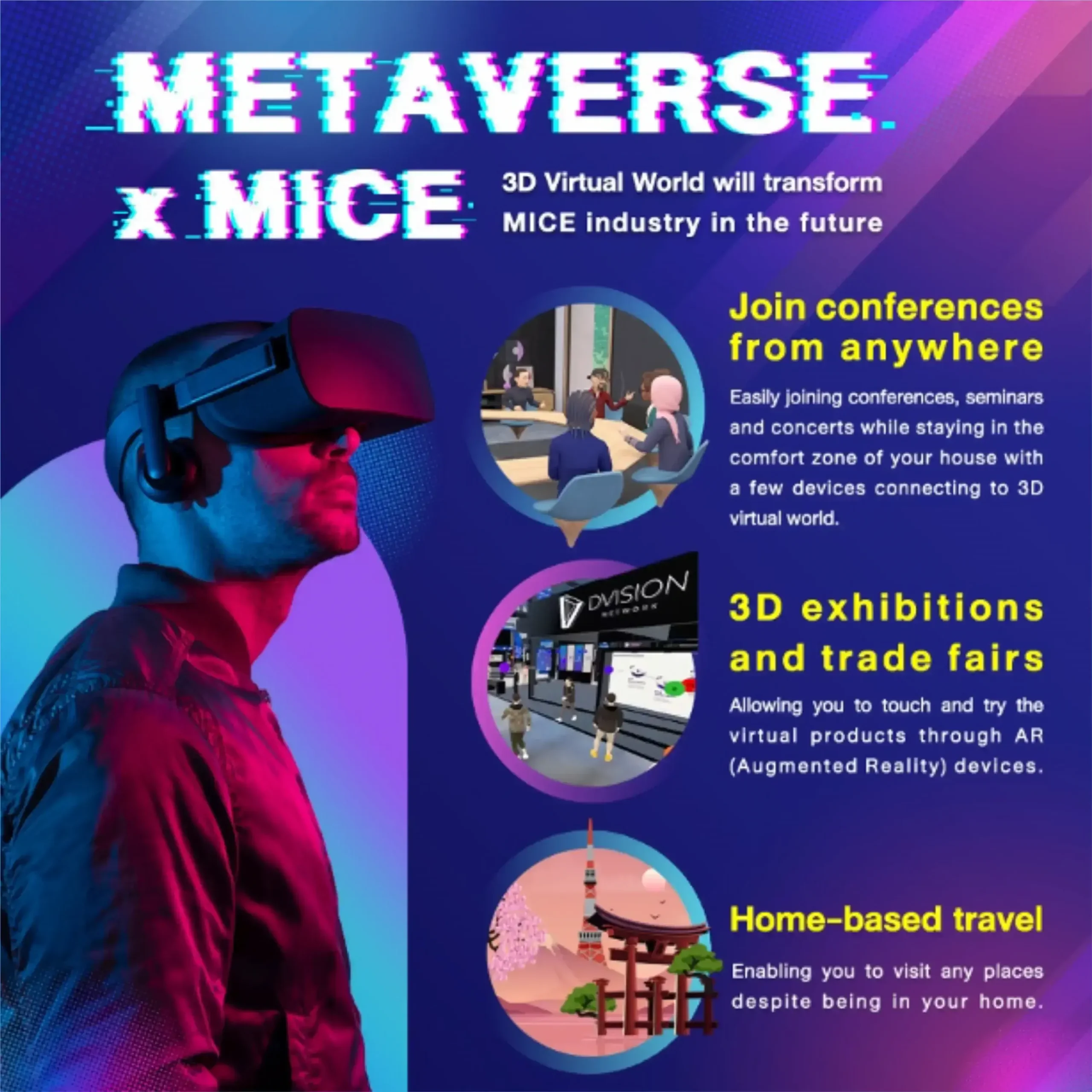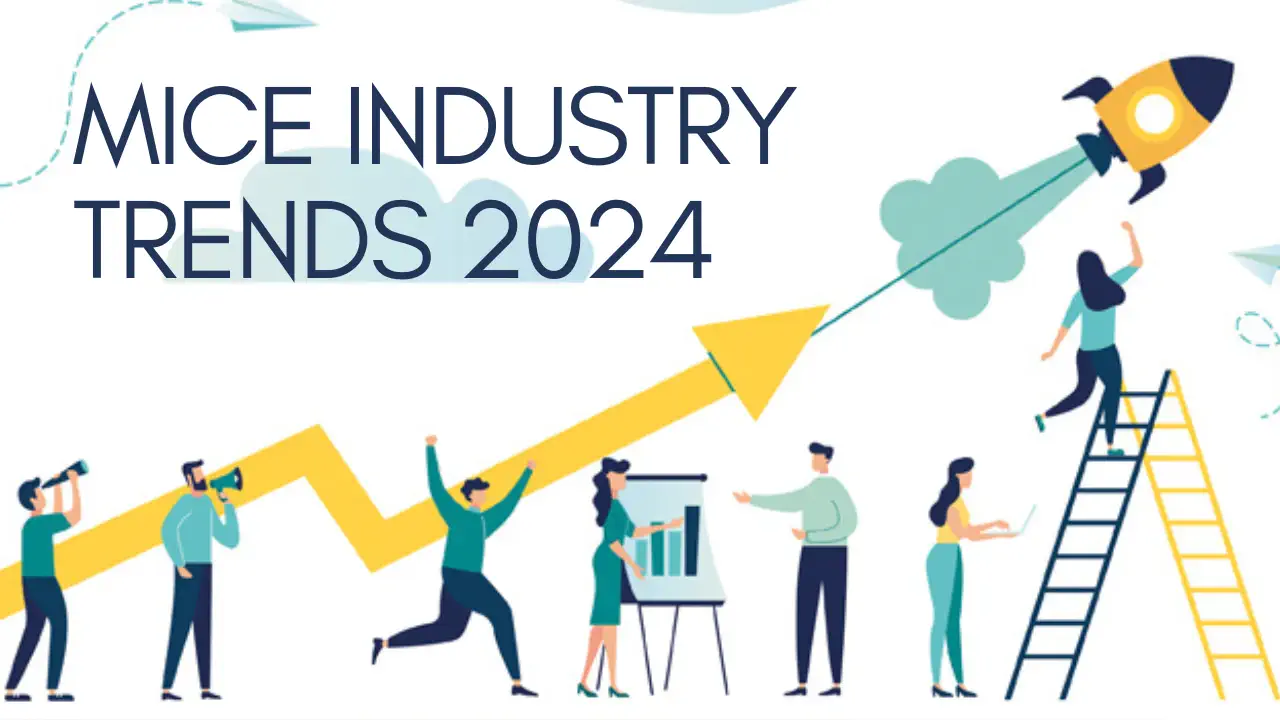The MICE industry which is a lucrative part of the tourism mix, stands for Meetings, Incentives, Conferences, and Exhibitions. It is a vibrant industry that plans influential conferences and events and is expected to undergo significant changes this year. This blog acts as a guide, helping enthusiasts and professionals in the field navigate the emerging MICE Industry trends that will influence the travel sector in the coming year.

Top MICE Industry Trends of 2024
1. Hybrid Events gain spotlight
The MICE sector is observing a paradigm shift toward hybrid events in 2024 and is one of the most prominent MICE Industry trend of 2024. The line that separates virtual and real locations is blurring, opening the door for new kinds of events. An Event MB poll revealed that 72% of event professionals believe hybrid events would remain popular, signalling an important change in how the industry operates.
The concept of the hybrid event seems a very conscious move for better accessibility and engagement and most importantly plays a pivotal role in countering the pandemic challenges. Presenters are using state-of-the-art technology more often to combine virtual and in-person elements smoothly, giving participants from all over the world a comprehensive experience.
The numbers reveal a great deal about the development of the sector. Experts estimate that the global market for hybrid events will reach a healthy compound annual growth rate (CAGR) of 19.7% through 2024, from a valuation of $23.5 billion in 2023. This shows the industry’s dedication to adopting hybridity as a long-term rather than a band-aid solution.
Estimate of Monetary Value: Due to the ongoing expansion and monetisation of hybrid event models, it is projected that the global market for hybrid events will have an economic impact of $31.5 billion by the end of 2024.
2. Sustainable Meetings gain traction
With the rise of environmental concerns, sustainability is no longer a MICE industry trend but an essential component of event planning across the world. Amid this, the MICE sector comes with sustainable practices as businesses realise the importance of lowering environmental impacts.
It is evident that sustainable gatherings are gaining traction. A recent Deloitte study found that while choosing whether or not to attend an event, 58% of consumers actively assess a company’s environmental impact. This consumer attitude influences event planners to take environment-friendly actions, such as cutting trash, starting recycling programs, and planning carbon-neutral events.
3. Carbon Zero Events: Paving the way to a Greener Future
The MICE sector has gone a long way toward organising carbon-zero events this year. The need to address climate change has forced event planners to reconsider their strategy and prioritise sustainability. The goal of hosting carbon-zero events is to reduce and offset the carbon impact that comes with organising large-scale gatherings.
The idea of carbon-neutral events entails a complex strategy. To power venues, event organisers are investing in alternative energy sources like solar and wind power. Initiatives like investing in carbon offset programs and forestry projects are becoming increasingly important parts of event planning efforts.
Beyond just being a virtue signal, the commitment to carbon-zero events reflects an increasing demand from stakeholders and attendees who care about the environment. Increasing knowledge and interest in sustainable event practices is evident from the 25% increase in queries the Events Industry Council, a global advocate for the MICE industry, reports in relation to carbon-zero events.
Monetary Value Estimation: As the industry adopts sustainable techniques to address environmental issues and meet attendee expectations, the investment in carbon-neutral events is expected to reach $5.8 billion by 2024.
4. AI-Powered Personalization: Enhancing Attendee Experience
The MICE industry is changing the attendee experience by including Artificial Intelligence (AI). AI-driven solutions might surge this year that are intended to enhance and customise each aspect of the event experience. Artificial Intelligence is turning into the key to providing attendees with special and lasting experiences, from pre-event communications to on-site interactions.
The data supports AI’s expanding impact in the events sector. According to a thorough analysis by Allied Market Research, the worldwide AI market for the events sector is expected to rise at an unprecedented rate, with a projected value of $1.8 billion by 2024. AI is being used more and more by event planners to evaluate participant data, forecast preferences, and automate repetitive chores so they can concentrate on creating engaging events.
Estimated Monetary Value: By 2024, the MICE industry’s economic value from artificial intelligence (AI) is expected to surpass $2.5 billion, as businesses realise the productivity gains and improved experiences AI can provide for event planning.
5. Augmented Reality (AR) & Virtual Reality (VR) Integration
Immersive technologies are making a reputation for themselves in the MICE sector, particularly Augmented Reality (AR) and Virtual Reality (VR). Once thought to be futuristic, these technologies are now essential for producing interesting and dynamic event experiences. Anticipate a sharp increase in the use of AR and VR in 2024, as these technologies go past novelty and become essential resources for event planners.

This trajectory is compellingly described in the Global Augmented and Virtual Reality in the MICE Market Report. Forecasts show an astounding compound annual growth rate (CAGR) of 68.5% from 2020 to 2024, highlighting how quickly emerging technologies are being incorporated into traditional event planning.
Monetary Value Estimation: By 2024, the AR and VR markets in the MICE sector are expected to be worth $7.2 billion, indicating the substantial economic impact of immersive technology.
6. Health and Safety Protocols remain significant
After the worldwide health crisis, it is unavoidable to organise an event without ensuring health and safety. The strict measures put in place in response to COVID-19 remain crucial as we move through 2024, as they guarantee attendees’ safety and foster confidence in event participation.
The Professional Convention Management Association (PCMA) released a study that illuminates the industry’s dedication to health and safety. A resounding 87% of professionals involved in events think that health and safety protocols will still be important in 2024. Temperature monitors, cleaning stations, and contactless registration are becoming standard components of event planning procedures rather than one-time tricks.
Beyond just physical concerns, health and safety measures are integrated. A thorough approach to virtual attendee well-being is required for hybrid events, which are expected to be a popular trend in 2024. This includes secure data processing and strong online security measures. Anticipate cutting-edge solutions and technology intended to improve both physical and virtual well-being as the industry tries to strike a careful balance between safety and seamless experiences.
Monetary Value Estimation: It is anticipated that the MICE business will spend $4.5 billion globally in 2024 on health and safety measures, highlighting the substantial financial commitment required to guarantee the well-being of attendees.
7. Rise of Niche Events
The MICE business is seeing a rise in the popularity of specialized events in the age of mass customisation. These niche events provide attendees with a more customised and personal experience by catering to particular sectors, hobbies, or communities. This shift is clearly displayed by the Eventbrite 2024 Trend Report, which shows a significant 32% increase in niche events over the prior year.
Niche events are attractive because they foster a sense of belonging and common interests. Niche events help people who share similar interests interact meaningfully, whether it’s a conference on emerging developments in artificial intelligence or a summit on sustainable technology. Anticipate a variety of speciality events in 2024, each tailored to the specific requirements and goals of its target audience.
Monetary Value Estimation: In 2024, niche events are expected to bring in $6.8 billion to the worldwide MICE sector, demonstrating the importance of carefully chosen and customized experiences from an economic standpoint.
8. Data-Driven Decision Making
In the MICE sector, data has become a potent driver for well-informed decision-making. By 2024, using data analytics to organize successful events will no longer be only a best practice—it will be a strategic need. In order to create more meaningful and targeted events, event planners are utilizing data to obtain deep insights into the behaviour, preferences, and levels of involvement of attendees.
A Cvent poll found that 89% of event professionals stressed the importance of data analytics in event planning provides evidence for the reliance on data. This figure demonstrates how the industry views data as a transformative tool that can influence event planning and produce significant results.
The MICE sector offers a wide range of data analytics services. Through the analysis of attendance demographics and engagement metrics, event organizers are continuously improving their approach by leveraging data. A growing trend, predictive analytics gives event planners the ability to foresee trends, spot possible problems, and proactively customize events to match participants’ changing demands.
Monetary Value Estimation: By 2024, the MICE industry’s economic benefit from data-driven decision-making is expected to exceed $3.2 billion, a reflection of the growing dependence on data for strategic event planning.
Final Thoughts – Best MICE Industry Trends
In 2024, the MICE sector is poised for a revolutionary shift, and the state of the economy is just as changing as the trends themselves. Emerging trends depict a business that is always changing, from the prevalence of hybrid events to the careful incorporation of sustainability, AI, AR, and VR. Adopting these trends as professionals in the field is not only a matter of preference; it is a strategic need.
The data, analysis, and financial projections provided in this examination of new developments, such as the inclusion of carbon-zero events, highlight how critical it is to remain aware of how the MICE sector’s economy is changing. Events in 2024 will be more than just social gatherings; they will be immersive, meaningful experiences, and the economic value of these trends will be a testimony to the industry’s dedication to excellence and innovation.
Let these MICE Industry trends, along with their economic ramifications, be our beacons as we navigate the complexity of this ever-evolving sector. They will pave the way to a future in which MICE events will surpass expectations and turn into catalysts for profound relationships and life-changing experiences.
